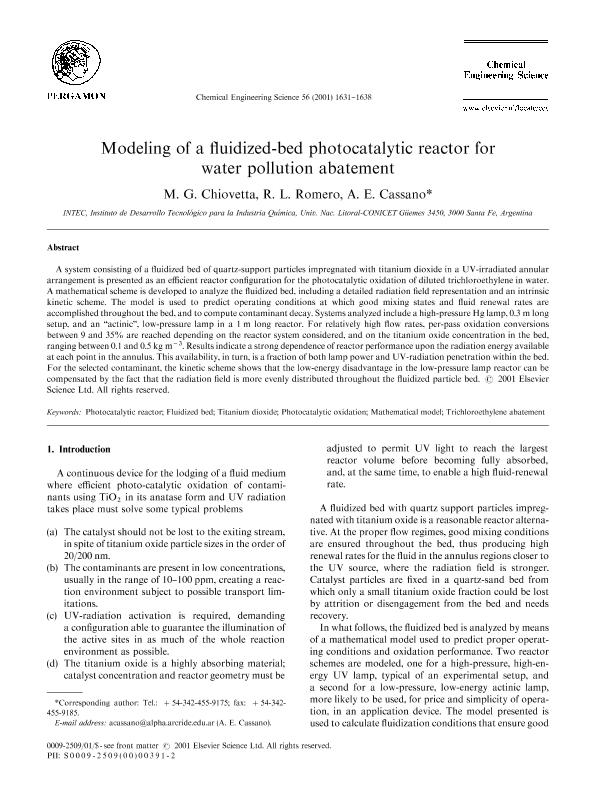Mostrar el registro sencillo del ítem
dc.contributor.author
Chiovetta, Mario Gabriel

dc.contributor.author
Romero, Roberto Leopoldo

dc.contributor.author
Cassano, Alberto Enrique

dc.date.available
2017-12-10T14:29:48Z
dc.date.issued
2001-12
dc.identifier.citation
Chiovetta, Mario Gabriel; Romero, Roberto Leopoldo; Cassano, Alberto Enrique; Modeling of a fluidized-bed photocatalytic reactor for water pollution abatement; Pergamon-Elsevier Science Ltd.; Chemical Engineering Science; 56; 4; 12-2001; 1631-1638
dc.identifier.issn
0009-2509
dc.identifier.uri
http://hdl.handle.net/11336/30053
dc.description.abstract
A system consisting of a fluidized bed of quartz-support particles impregnated with titanium dioxide in a UV-irradiated annular arrangement is presented as an efficient reactor configuration for the photocatalytic oxidation of diluted trichloroethylene in water. A mathematical scheme is developed to analyze the fluidized bed, including a detailed radiation field representation and an intrinsic kinetic scheme. The model is used to predict operating conditions at which good mixing states and fluid renewal rates are accomplished throughout the bed, and to compute contaminant decay. Systems analyzed include a high-pressure Hg lamp, long setup, and an “actinic”, low-pressure lamp in a long reactor. For relatively high flow rates, per-pass oxidation conversions between 9 and 35% are reached depending on the reactor system considered, and on the titanium oxide concentration in the bed, ranging between 0.1 and . Results indicate a strong dependence of reactor performance upon the radiation energy available at each point in the annulus. This availability, in turn, is a fraction of both lamp power and UV-radiation penetration within the bed. For the selected contaminant, the kinetic scheme shows that the low-energy disadvantage in the low-pressure lamp reactor can be compensated by the fact that the radiation field is more evenly distributed throughout the fluidized particle bed.
dc.format
application/pdf
dc.language.iso
eng
dc.publisher
Pergamon-Elsevier Science Ltd.

dc.rights
info:eu-repo/semantics/openAccess
dc.rights.uri
https://creativecommons.org/licenses/by-nc-sa/2.5/ar/
dc.subject.classification
Otras Ingeniería Química

dc.subject.classification
Ingeniería Química

dc.subject.classification
INGENIERÍAS Y TECNOLOGÍAS

dc.title
Modeling of a fluidized-bed photocatalytic reactor for water pollution abatement
dc.type
info:eu-repo/semantics/article
dc.type
info:ar-repo/semantics/artículo
dc.type
info:eu-repo/semantics/publishedVersion
dc.date.updated
2017-11-24T13:43:38Z
dc.journal.volume
56
dc.journal.number
4
dc.journal.pagination
1631-1638
dc.journal.pais
Países Bajos

dc.description.fil
Fil: Chiovetta, Mario Gabriel. Consejo Nacional de Investigaciones Científicas y Técnicas. Centro Científico Tecnológico Conicet - Santa Fe. Instituto de Desarrollo Tecnológico para la Industria Química. Universidad Nacional del Litoral. Instituto de Desarrollo Tecnológico para la Industria Química; Argentina
dc.description.fil
Fil: Romero, Roberto Leopoldo. Consejo Nacional de Investigaciones Científicas y Técnicas. Centro Científico Tecnológico Conicet - Santa Fe. Instituto de Desarrollo Tecnológico para la Industria Química. Universidad Nacional del Litoral. Instituto de Desarrollo Tecnológico para la Industria Química; Argentina
dc.description.fil
Fil: Cassano, Alberto Enrique. Consejo Nacional de Investigaciones Científicas y Técnicas. Centro Científico Tecnológico Conicet - Santa Fe. Instituto de Desarrollo Tecnológico para la Industria Química. Universidad Nacional del Litoral. Instituto de Desarrollo Tecnológico para la Industria Química; Argentina
dc.journal.title
Chemical Engineering Science

dc.relation.alternativeid
info:eu-repo/semantics/altIdentifier/doi/http://dx.doi.org/10.1016/S0009-2509(00)00391-2
Archivos asociados
